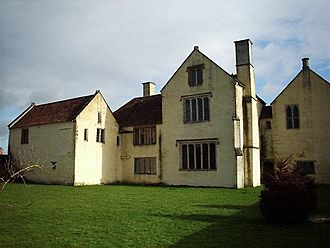Gurney Manor facts for kids
Quick facts for kids Gurney Manor |
|
|---|---|
 |
|
| General information | |
| Town or city | Cannington, Somerset |
| Country | England |
| Coordinates | 51°09′00″N 3°03′21″W / 51.1499°N 3.0559°W |
| Completed | 13th century |
Gurney Manor is a very old and special house located in Cannington, Somerset, England. It was built way back in the 13th century, which means it's over 700 years old! This amazing building is a manor house, which was a large country house owned by a lord or important person. It even has a small chapel wing attached to it.
Today, Gurney Manor is looked after by the Landmark Trust, a charity that saves historic buildings. You can even stay there for a holiday! It's considered a very important building and is listed as a Grade I listed building. This means it's one of the most important historic buildings in England. It's special because so much of its original medieval (Middle Ages) structure is still standing.
Contents
Gurney Manor: A Journey Through Time
Gurney Manor has a long and interesting history. The very first building on this spot was an "open hall house." This was a simple home with a large open room in the middle. It was built before the year 1350.
How the Manor Grew
Around the year 1400, the house was rebuilt. Over the next 100 years, many parts were added. A man named William Dodisham added a south wing, a porch, and a kitchen. He also put in new windows to make the house brighter.
In 1480, William Dodisham left the manor to his niece, Agnes. She married a local landowner named Walter Michael. Their family and their children's families owned Gurney Manor for many years. They kept improving the house until 1616.
From Manor to Farmhouse
After 1616, Gurney Manor became a farmhouse. It was often rented out to people who farmed the land. For about 300 years, the house didn't get many new updates. But the good news is, it also didn't get changed much from its original design. This helped keep its historic look.
During World War II, the house was divided into smaller apartments by a Mr. Harris. His family later sold the manor to the Landmark Trust in the 1980s. Inside the house, you can still see parts of a beautiful plaster ceiling from the 17th century. It has fancy patterns called "strapwork."
Bringing the Past to Life
In the late 20th century, a lot of work was done to restore Gurney Manor. This restoration fixed problems with the building's structure. Workers also built new oak roof beams. They made these beams in a very old-fashioned way, using traditional tools like an adze. An adze is a special tool that looks a bit like an axe, used for shaping wood. This careful work helped to bring Gurney Manor back to its former glory.

